Manga "Entertaining statistics", "The Mystery of Disasters" and other similar books
We are talking about unusual textbooks that stand in the middle between high school textbooks and purely popular science brochures. Nevertheless, there is a clear dividing line between scientific schools and such textbooks - the latter are aimed specifically at learning, entertainment chips are just a form of presenting serious material. The general for all such books, as it seems to me - the presentation of the material in the form of a comic book and / or in the form of a dialogue of two or more people. Usually two interlocutors - a student and a teacher, one constantly asks questions, often stupid or funny, the second tries to explain in a playful way.
In the post a lot of screenshots of several books. One of them, which I completely recast about the catastrophes and posted pdf. I ask to consider, under habrakat not one megabyte of pictures, the text is much less. I apologize in advance for the quality of some shots - the night reshoot did not help. Perhaps there are more pictures than necessary, but I tried to show the basic principles - the graphic, game way of presenting the material, the plot and the dialogues.
I did something like a retrospective: the first book is a fresh Japanese comic-manga about the mathematics of the 2010 edition, then a book from the 80s about mathematics, the theory of catasrophs. The latter is a beginner’s radio electronics tutorial, familiar to several generations of readers around the world since the 1930s.
')
To illustrate the post, I’ll give the cover of another manga from the same series as the book on statistics:

Quanta, today we quanti with you ... Japanese comics.
Go ahead ... More serious mathematics in a simpler language.
How it all began ...
Also in the 90s I met several translated American comics about the economy. General topics were explained - goods, money supply, inflation, laws of supply and demand, etc. A little to the side - I saw gaming books on chess and the game of go.
I tried to search the web for something similar, but I saw only 2-3 books that were really similar in meaning. The rest is just about scientific jokes. Have you seen anything like this? Further some links.
Maybe someday you will be lucky to find such books about various sections of higher mathematics, algorithms and theorphism. Or, say, to see once some complicated course in the form of a cartoon. It is possible to even more dream up and present a series of such books in Russian, written “with a twinkle” by a team of teachers, scriptwriters and artists, for different levels, from junior high school students to students ... other.
In the post a lot of screenshots of several books. One of them, which I completely recast about the catastrophes and posted pdf. I ask to consider, under habrakat not one megabyte of pictures, the text is much less. I apologize in advance for the quality of some shots - the night reshoot did not help. Perhaps there are more pictures than necessary, but I tried to show the basic principles - the graphic, game way of presenting the material, the plot and the dialogues.
I did something like a retrospective: the first book is a fresh Japanese comic-manga about the mathematics of the 2010 edition, then a book from the 80s about mathematics, the theory of catasrophs. The latter is a beginner’s radio electronics tutorial, familiar to several generations of readers around the world since the 1930s.
')
To illustrate the post, I’ll give the cover of another manga from the same series as the book on statistics:

Quanta, today we quanti with you ... Japanese comics.
Interesting statistics - manga from Sina Takahashi. Many pictures
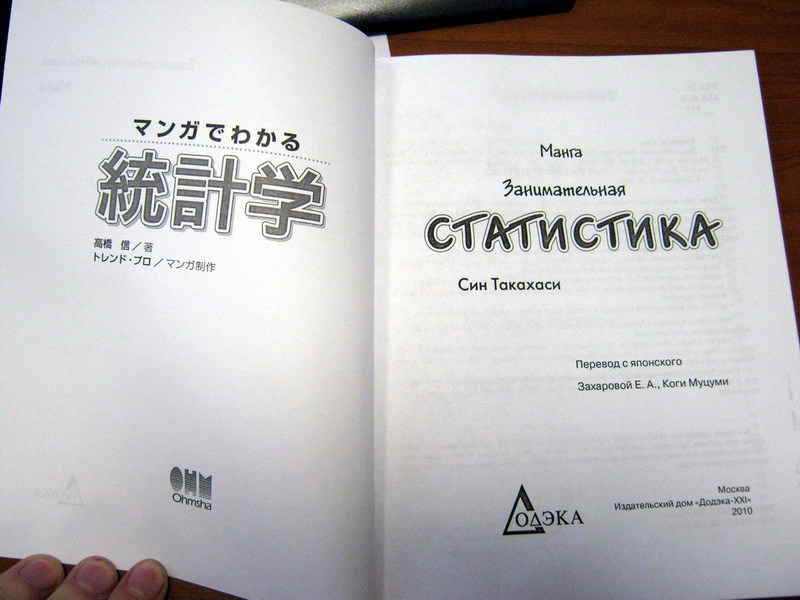
Content on Ozone
Almost all the people to whom I showed this book said “well, why did I not have such a textbook at the institute ?!”
The plot is this: Japanese schoolgirl Rui, the daughter of a director of a corporation, is interested in an adult employee of her father. After learning that he is at work engaged in marketing and statistics , she asks her dad to arrange her lessons with this guy. He happily agrees, but, oh, horror - as a result, “another young man, Yamamoto, comes to replace him.” Since Rui has already brewed porridge, you have to take home lessons on the stated topic - statistics ...
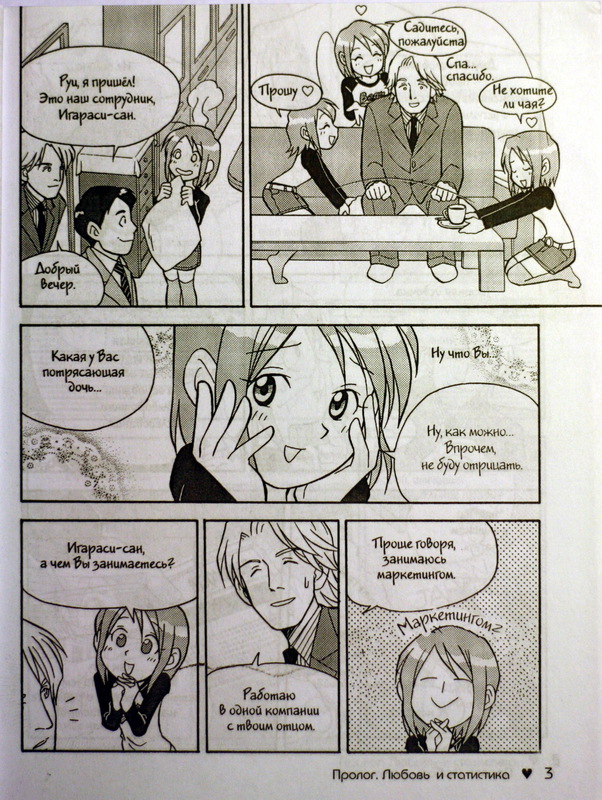
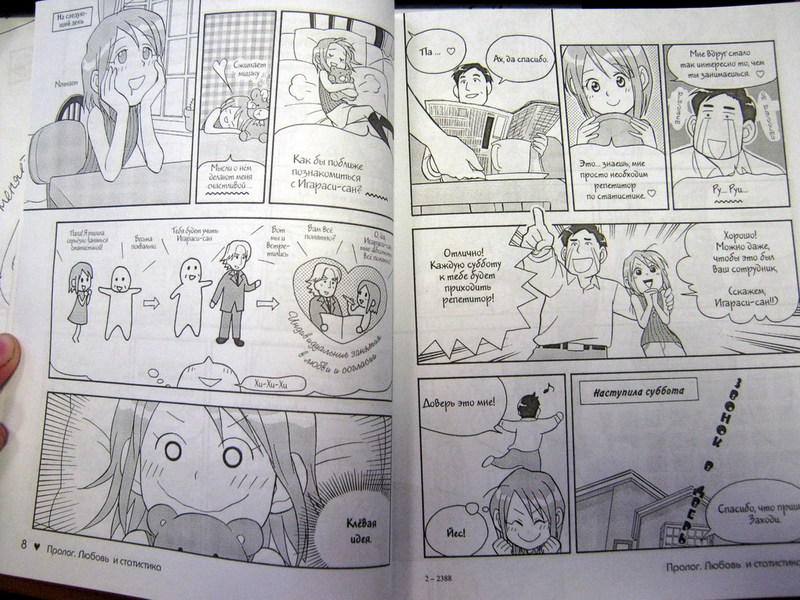
As a result, in the dialogues in the pictures, qualitative concepts unobtrusively go over to tables, histograms, Gaussoid plots, formulas with density integrals of distributions.

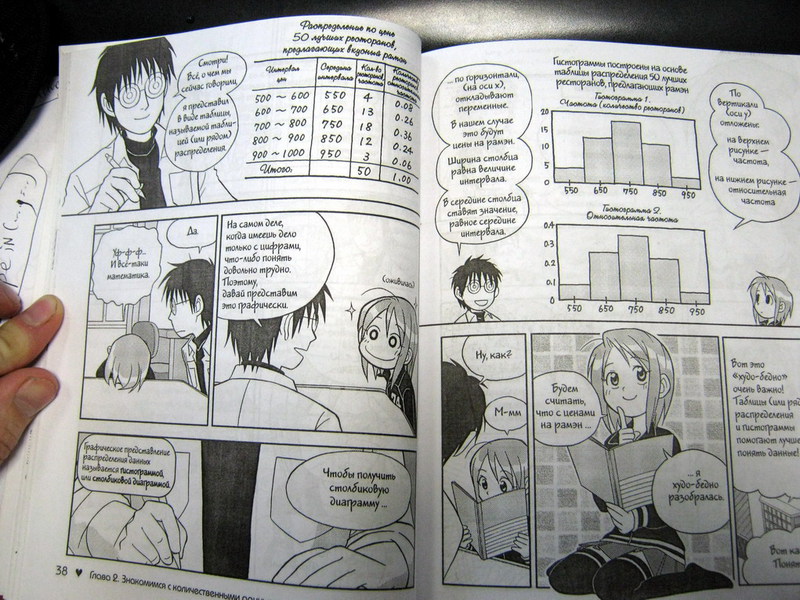
Rui suffers, but gradually moves forward. Also in the next chapter, a girlfriend appears who is better able to deal with the concept of normalized deviation.
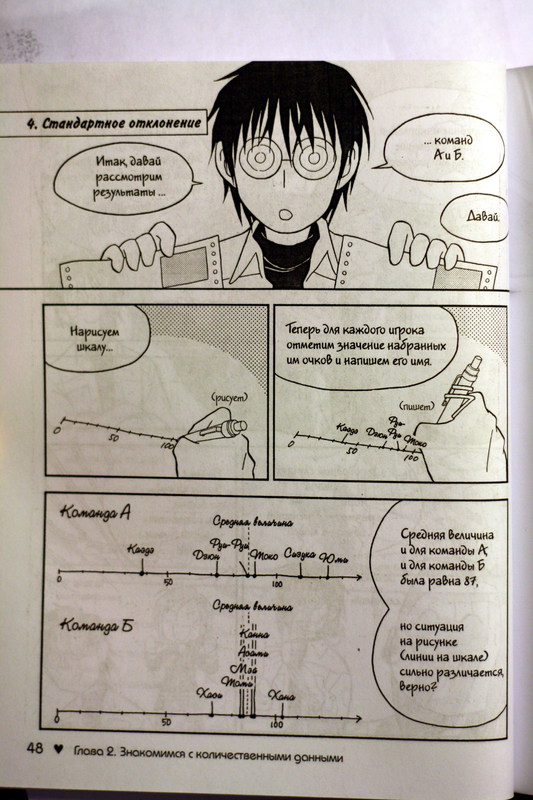
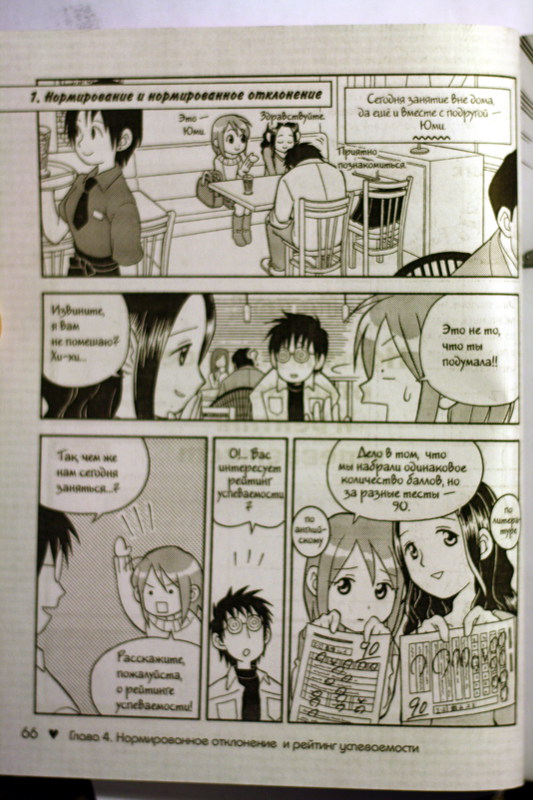


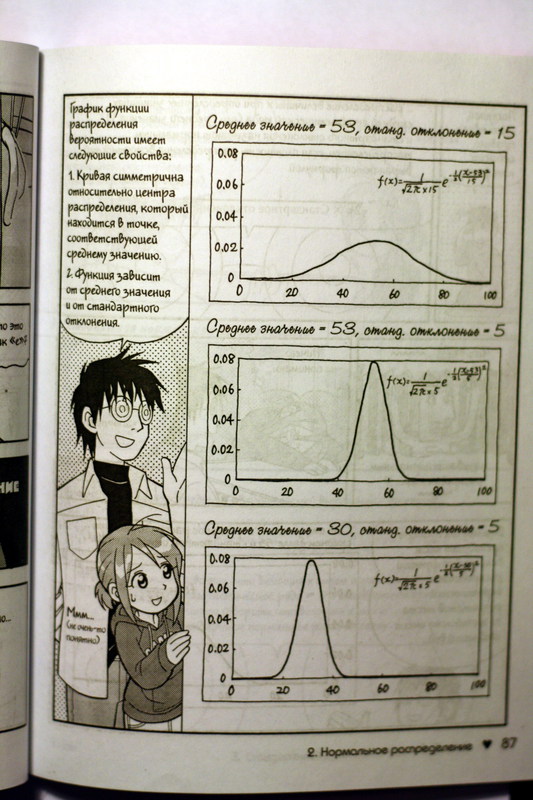
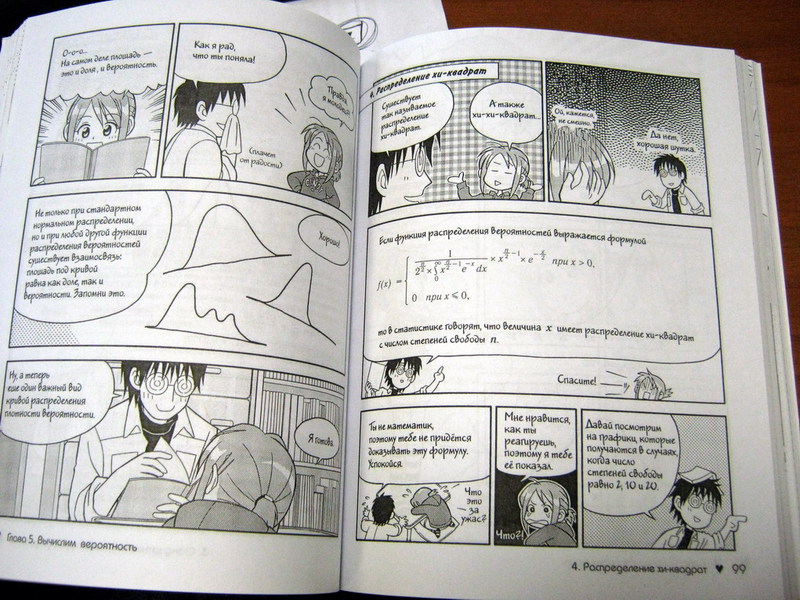

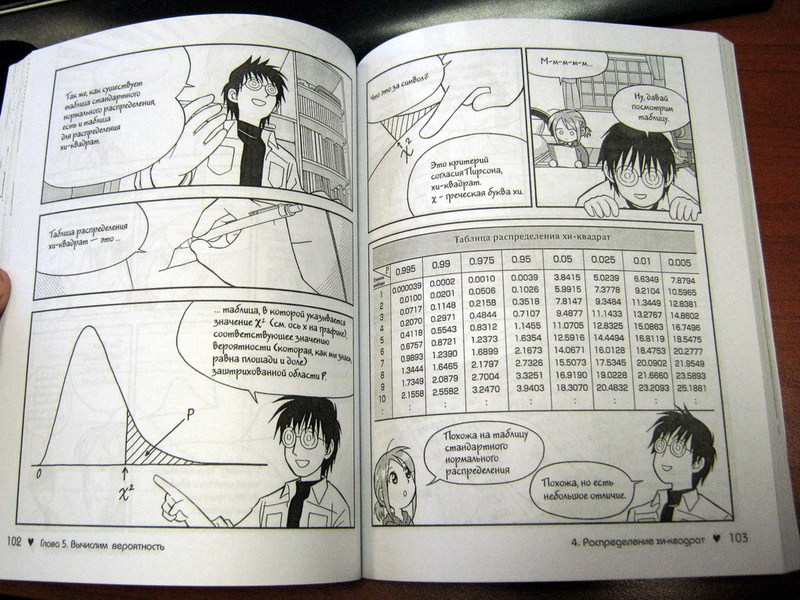
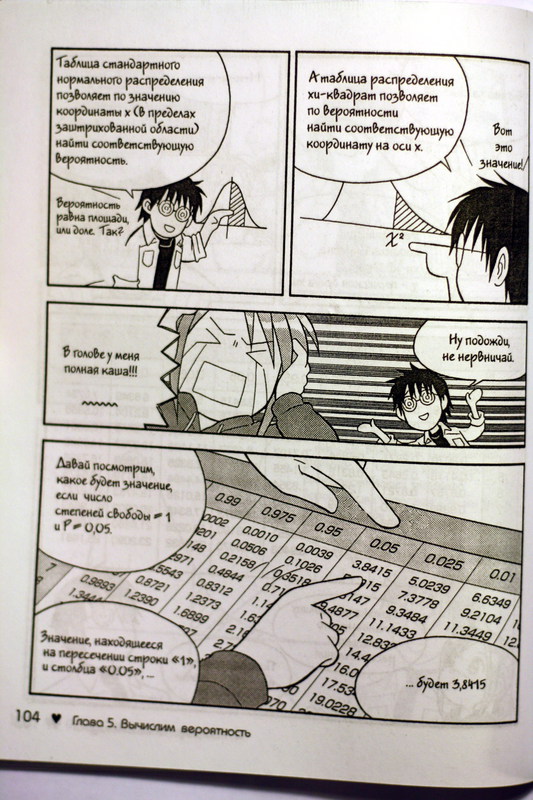

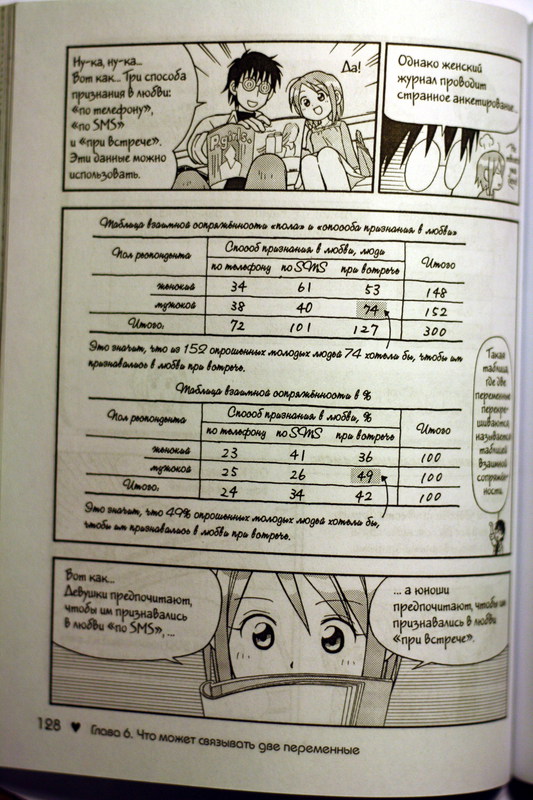
It all ends too predictably:
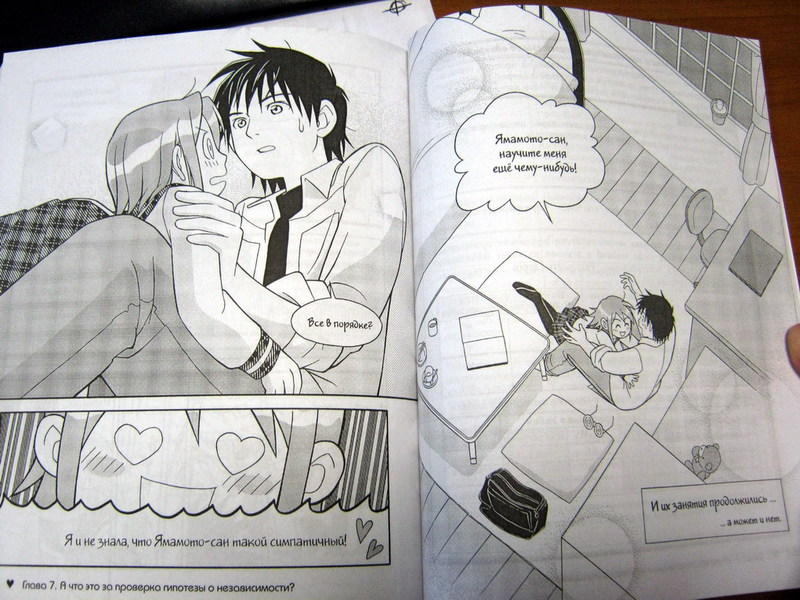
After which there are many pages of applications. These are mainly examples of the use of statistical functions with screenshots of Excel plates.
In the same series there are books by other authors - about mechanics, electricity, astronomy and mathematical analysis.


Content on Ozone
Almost all the people to whom I showed this book said “well, why did I not have such a textbook at the institute ?!”
The plot is this: Japanese schoolgirl Rui, the daughter of a director of a corporation, is interested in an adult employee of her father. After learning that he is at work engaged in marketing and statistics , she asks her dad to arrange her lessons with this guy. He happily agrees, but, oh, horror - as a result, “another young man, Yamamoto, comes to replace him.” Since Rui has already brewed porridge, you have to take home lessons on the stated topic - statistics ...


As a result, in the dialogues in the pictures, qualitative concepts unobtrusively go over to tables, histograms, Gaussoid plots, formulas with density integrals of distributions.


Rui suffers, but gradually moves forward. Also in the next chapter, a girlfriend appears who is better able to deal with the concept of normalized deviation.











It all ends too predictably:

After which there are many pages of applications. These are mainly examples of the use of statistical functions with screenshots of Excel plates.
In the same series there are books by other authors - about mechanics, electricity, astronomy and mathematical analysis.
Go ahead ... More serious mathematics in a simpler language.
Ian Stewart. The mystery of disaster. Too many pictures
A comic book is a qualitative introduction to the theory of catastrophes. The author has quite an adult textbook on this topic, a comic appeared for a popular introduction to a complex area of mathematics . According to the definition of the mathematician V. Arnold:
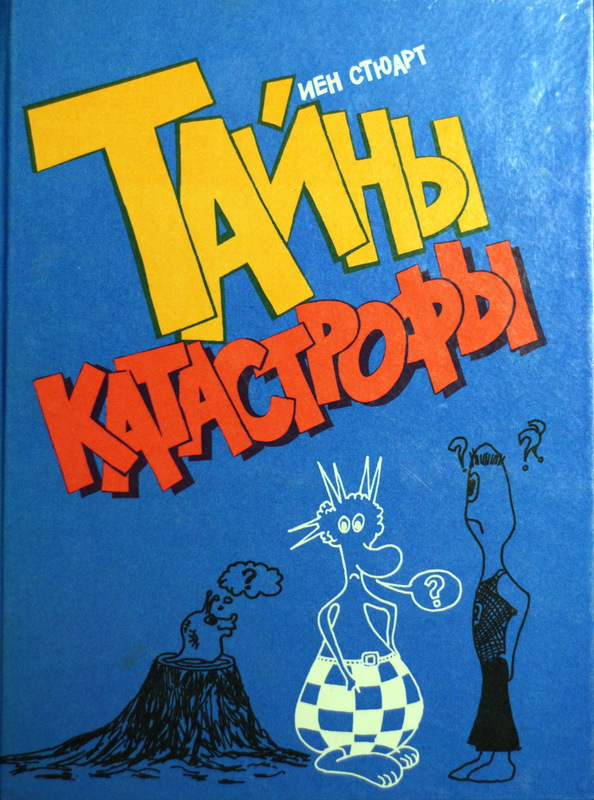
The characters of Stuart Rosa, Gaston and the little animal clips travel between times and clarify for themselves the topic of convolutions, bifurcations. Act takes place on the planet Ombiliicus, which has two suns. Graphics and drawings are there, almost no formulas. There are no serious formulas befitting the proposed material.
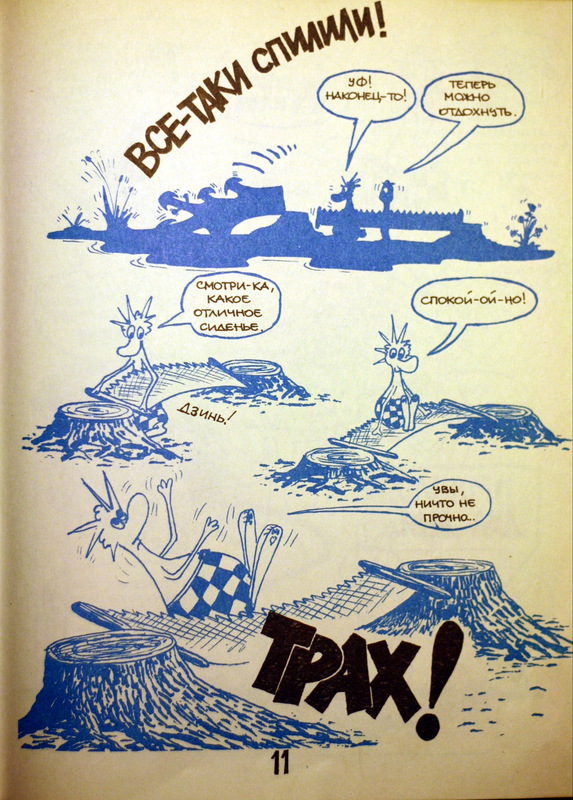
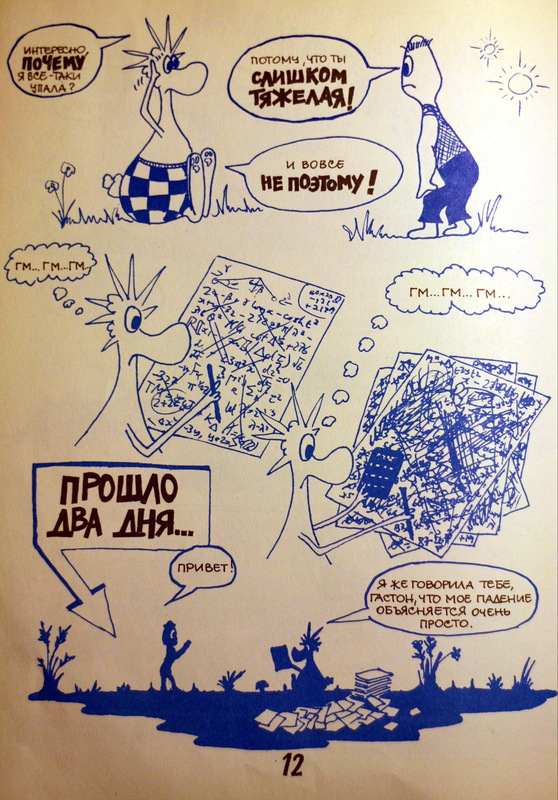

15
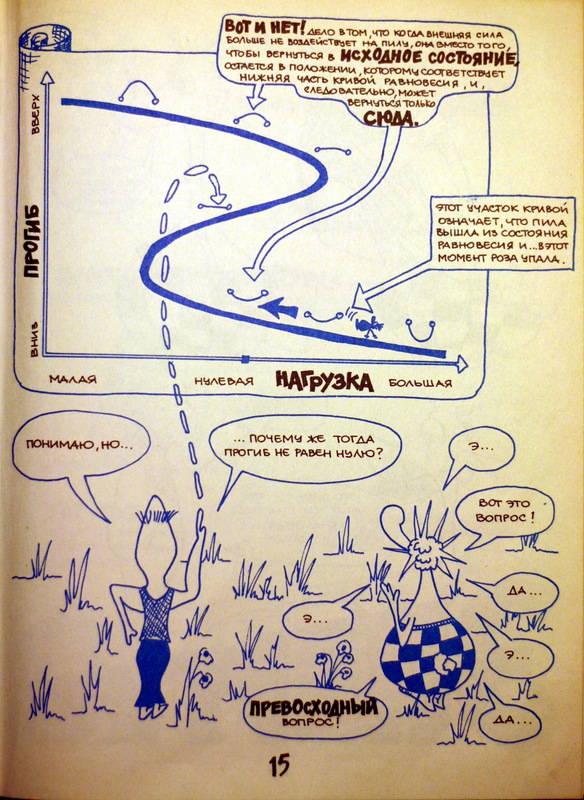
nineteen
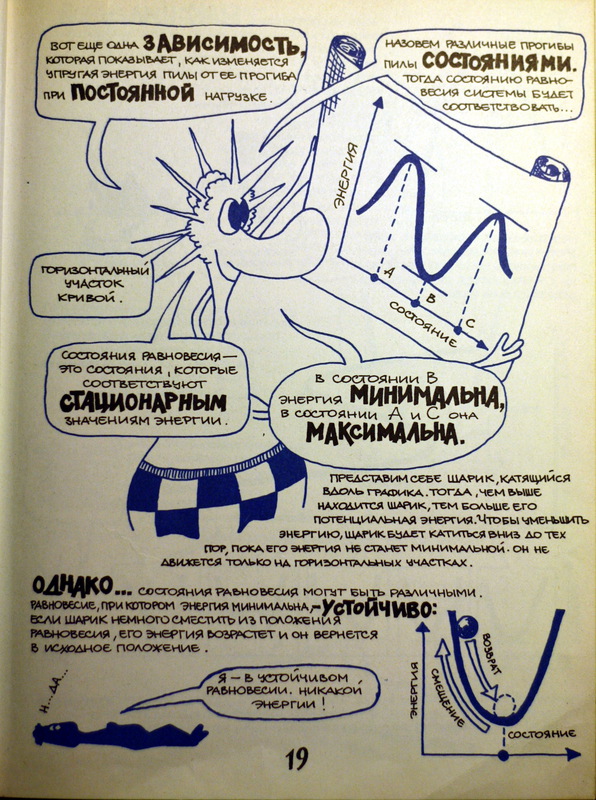
23

27
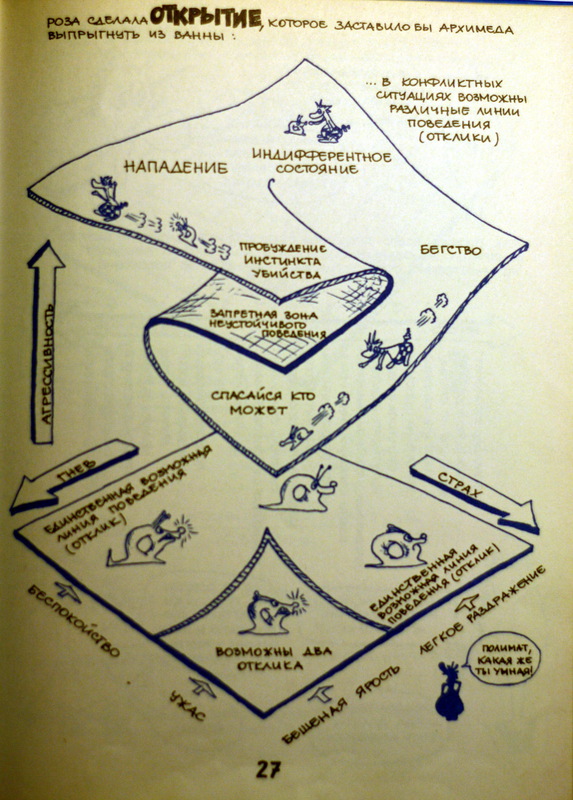
29-31
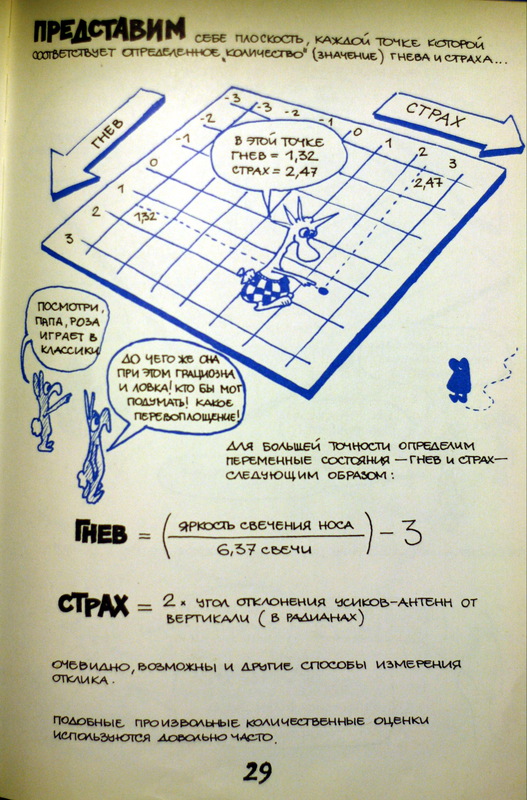
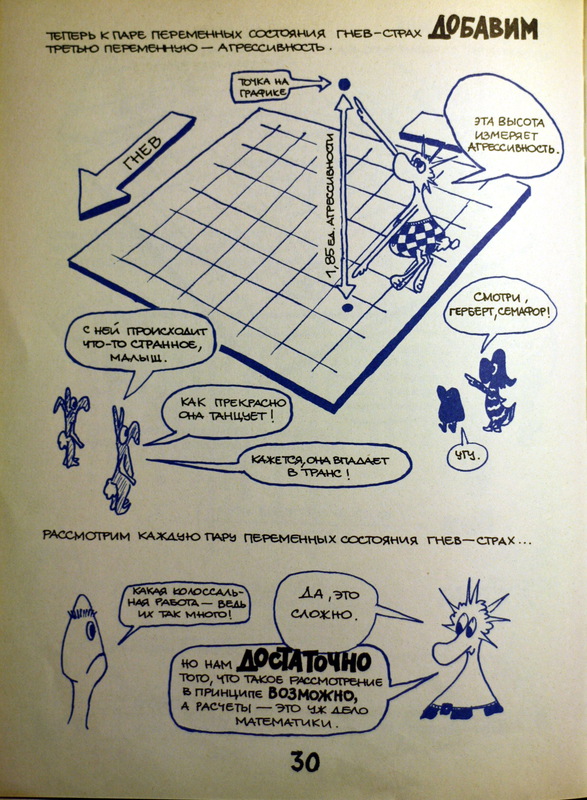
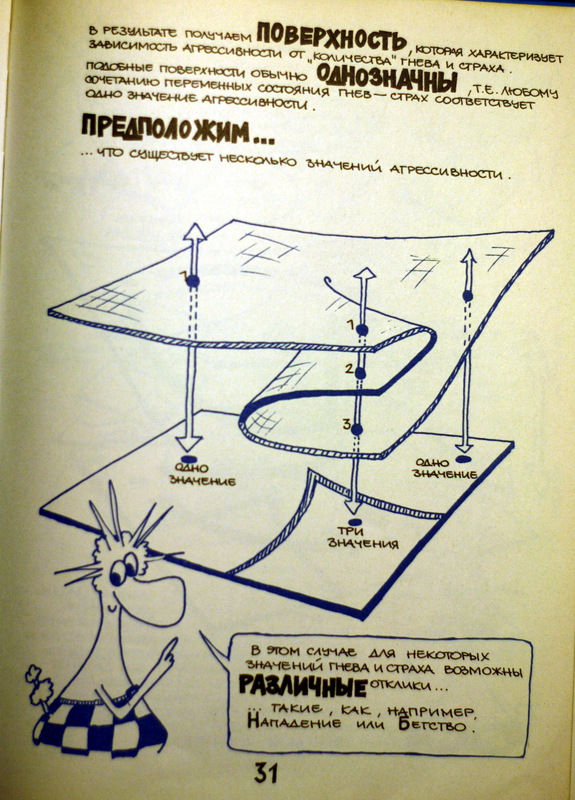
39

58
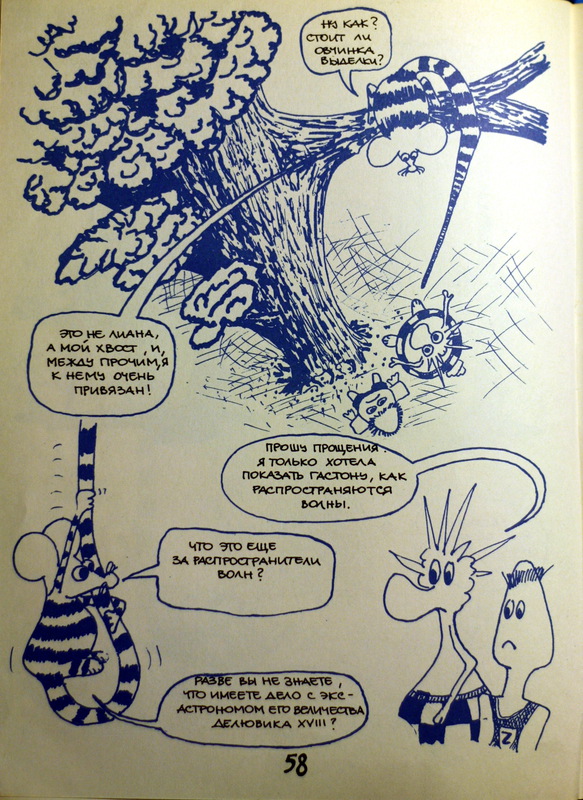
61
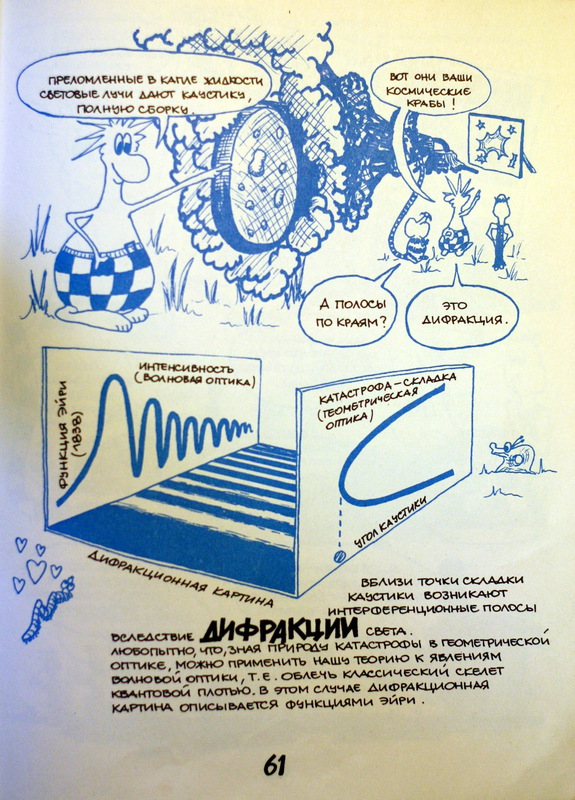
Digitized pdf can be taken here.
“Disasters are called catastrophes, resulting in a sudden response of the system to a smooth change in external conditions. Sources of the theory of catastrophes are the theory of singularities of smooth maps and; theory of bifurcations of dynamical systems.

The characters of Stuart Rosa, Gaston and the little animal clips travel between times and clarify for themselves the topic of convolutions, bifurcations. Act takes place on the planet Ombiliicus, which has two suns. Graphics and drawings are there, almost no formulas. There are no serious formulas befitting the proposed material.



15

nineteen

23

27

29-31



39

58

61

Digitized pdf can be taken here.
How it all began ...
E.D. Iceberg. Radio? It is very easy!
Perhaps this is how all such publications began. In 1925, the family of the famous Odessa pianist Davyd Iceberg went to France for treatment or, there, on a tour and did not return. His son Eugene Iceberg publishes in the 30s. in Paris, a textbook of radio electronics in the form of a conversation between two friends - the wise by experience Lyuboznaykin and the weak, frivolous beginner Neznaikin. As a result, at the end of their conversations, Neznaikin himself assembles his receiver. And not only is he alone - according to reviews, in the late 60s and later, many people studied and collected their devices using this book. Although the book is formally not a comic book, but it is close to it - the text accompanies a large number of pictures in the margins, then there are drawings and radio circuits.
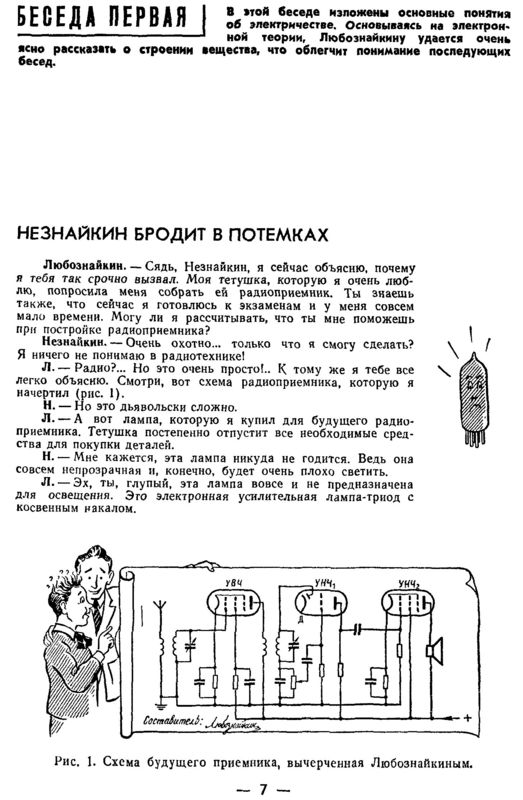


Such books began in the early 30s, withstood many reprints after the war, were published en masse in many languages. These are not comics, but very similar to them. Books are built as a dialogue of Neznaikin and Lyuboznaykin with drawings on the margins. With the development of radio engineering, Iceberg had to correct their conversations. In the editorial board of the Soviet editions of all his books, the first in the list can be seen academician Axel Berg. The history of these books is a story of tremendous success.
After the lamps went transistors - is there a publication of “ Radio? - It's very easy! “Where transistors are introduced - after a lengthy piece of information about electrons, pnn junctions, etc.
Separately, there is a book dedicated only to transistors Transistor? - It's very easy! (the link is scanned by page). In the 70s appeared in different variations “ Television - it is very simple! “And the team“ Radio and TV? - It's very easy! “A friend of mine told me that he had been studying a book on television at school and, in the end, had collected his TV. Surely he was helped, besides, a separate kinescope and a bunch of specific details could then be obtained only by disassembling the finished telly. Personally, I had a meeting with Iceberg’s books at school, but for various reasons the television did not go, but the radio had a chance to solder many small handicrafts.
My father used to study these books in his time, and I - in middle classes. Although now it seems to me that I did not reach much ... I soldered something on transistors, but without a deep understanding. But on the lamps I did nothing at all - I did not see anywhere in the sale of "pure" triodes. But soldered according to the scheme of UT adjustable rectifier from 0.7 to 12V and VHF receiver from the designer. It was an amazing feeling!
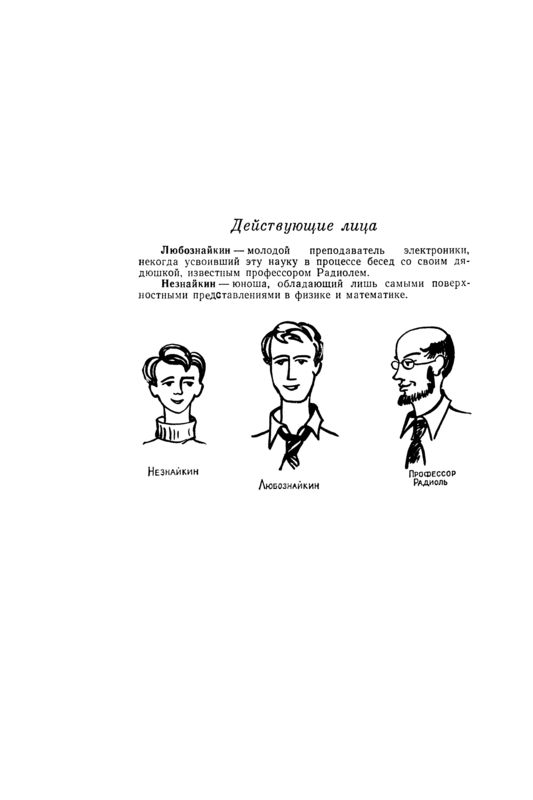

There have also been the continuation of at least one more author, Jean-Paul Amision Electronics? .. There is nothing easier! . It can be seen that the entire outline remains the same, all the heroes also migrated, but the drawings and topics of conversations changed.



Such books began in the early 30s, withstood many reprints after the war, were published en masse in many languages. These are not comics, but very similar to them. Books are built as a dialogue of Neznaikin and Lyuboznaykin with drawings on the margins. With the development of radio engineering, Iceberg had to correct their conversations. In the editorial board of the Soviet editions of all his books, the first in the list can be seen academician Axel Berg. The history of these books is a story of tremendous success.
After the lamps went transistors - is there a publication of “ Radio? - It's very easy! “Where transistors are introduced - after a lengthy piece of information about electrons, pnn junctions, etc.
Separately, there is a book dedicated only to transistors Transistor? - It's very easy! (the link is scanned by page). In the 70s appeared in different variations “ Television - it is very simple! “And the team“ Radio and TV? - It's very easy! “A friend of mine told me that he had been studying a book on television at school and, in the end, had collected his TV. Surely he was helped, besides, a separate kinescope and a bunch of specific details could then be obtained only by disassembling the finished telly. Personally, I had a meeting with Iceberg’s books at school, but for various reasons the television did not go, but the radio had a chance to solder many small handicrafts.
My father used to study these books in his time, and I - in middle classes. Although now it seems to me that I did not reach much ... I soldered something on transistors, but without a deep understanding. But on the lamps I did nothing at all - I did not see anywhere in the sale of "pure" triodes. But soldered according to the scheme of UT adjustable rectifier from 0.7 to 12V and VHF receiver from the designer. It was an amazing feeling!


There have also been the continuation of at least one more author, Jean-Paul Amision Electronics? .. There is nothing easier! . It can be seen that the entire outline remains the same, all the heroes also migrated, but the drawings and topics of conversations changed.
Also in the 90s I met several translated American comics about the economy. General topics were explained - goods, money supply, inflation, laws of supply and demand, etc. A little to the side - I saw gaming books on chess and the game of go.
I tried to search the web for something similar, but I saw only 2-3 books that were really similar in meaning. The rest is just about scientific jokes. Have you seen anything like this? Further some links.
Links
- A blog reviewing science and history comics
- sci-ence.org Lots of small comics, mostly entertaining. Many biological and psychological, jokes of glasses of "Augmented Reality" Google are noticed.
- sci-ence.org/clearing-the-air
- Sce-ence.org Permitted and prohibited reactions to the observed interference pattern:

- sci-ence.org/dirty-upbringing
- www.madsciencecomic.com
- XKCD Famous Place
- Science Comics plus. The Cartoons of S. Harris Just funny pictures on scientific topics. It seems that some of the bottom are found in "Physicists joking"
- PhD Comics . Almost no science, but funny.
- Larry Gonik. Introduction to statistics in pictures
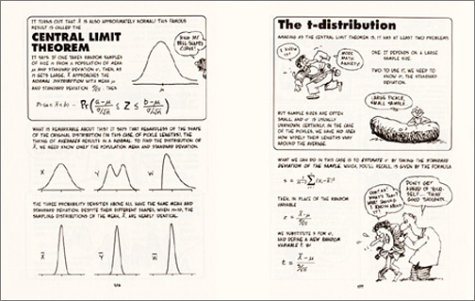
- Larry Gonik. Introduction to physics in pictures
- Comics on the device CD-drive, mouse, Internet and other "The New Way Things Work". $ 23 on Amazon

- ifanboy.com/articles/top-5-indie-comics-of-science
- How comics teach science This review mentions a reviewed manga on statistics, as well as a similar Introduction to Biochemistry, which was not translated into Russian.

- Biography of Alan Turing and Computer Science History Series
- A large archive of homemade comic books about math and science in general Spiked Math Comics, a few examples.
[1] , [2] , [3] - V. Arnold Theory of Disasters. Textbook
- Eugene Iceberg on Wikipedia Since he was an active Esperantist, there is an article about him on Esperanto. In English - no ...
- More about E.Aisberg
Maybe someday you will be lucky to find such books about various sections of higher mathematics, algorithms and theorphism. Or, say, to see once some complicated course in the form of a cartoon. It is possible to even more dream up and present a series of such books in Russian, written “with a twinkle” by a team of teachers, scriptwriters and artists, for different levels, from junior high school students to students ... other.
Source: https://habr.com/ru/post/169461/
All Articles